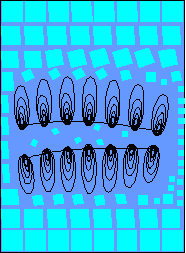Elementary particles are Cavities in the Ether.
|
Elementary particles are Cavities in the Ether.
|
Further readings concern the demystification of relativity and demystification of optics.
Some "proofs" for the ether model seem to come from the question"are there time atoms?" and the comparison between QCD and ether model.
But the dense material of the universe is not like a liquid. It is hard and brittle. It instantly fractures and cracks. And that´s, how the cavities migrate through this solid block: The material cracks and fracures all around the cavity, forming small grains and dust. And as this debris moves within the small cavity from one side to the other, the cavity itself is moved to the opposite side.
Thus, the material may almost be thought off as extremely solid sort of glass. It is hard and solid, rigid and tough, but - on the other hand - small forces instantly crack it and fracture it.
I call this material "ether", because this word has a great historical meaning. About 150 to 100 years ago, many intelligent scientists thought that the universe is filled by an ether, which was thought to be a dense material, about 100.000 times denser than water (Herschel). It was this ether, which - as people still say nowadays - transmits the radio waves and light. And, as Dr. Goldsteen of Caltec pointed out recently, some of the brightes scientists persued the idea of the atoms to be vortex rings in the ether.
However, the ether is different in many respects. Its density is much higher. In fact, its density is already known to phyisists as the density of the so called "nuclear fluid".
Let´s have a look at an elementary particle, say a proton: The proton corresponds to a cavity in the ether, which equals the cube of an elementary length. But the cavity is not cubic, it is not a bubble either. The cavity is distributed within a space, which can - to some extent - be caracterised by the "wave length" of the particle. Therefore the particle can be thought off as a sort of pile of grains. These grains are shaken up, tilted against each other, and there are small gaps between these grains. These gaps sum up to a total volume of a cubic elementary length.
As the "proton moves through space", the ether, where the proton is moving to, is shaken and fractures. The pieces migrate into to cavity, pushing the grains in the cavity together, which eventually will reassamble and thereby fill the gaps between them.
So, the movement of the proton corresponds to the movement of the same amount of ether material into the opposite direction. This understanding can easily explain a number of effects, which could not be explained before. It is - for instance - easily understandable, why the proton - as any elementary particle - seems to have different sizes at different occations.
The most important aspect to this thinking is that nature seems deeply rational. The ether ist homogenous with respect to density and other physical quantities. So, all physics seems to boil down - as Decartes already specualted - to pure geometric effects.
These geometric effects can be of different sort, and they can be complicated indeed. In fact, we may think at a variety of "vortex rings" within the pulverised ether, where the ether grains are essentially - by the sort of cracking - of cubic structure. These cubic elements twist and push each other, and eventially they will reassemble and form a sort of brick wall without any gaps.
This way of thinking may certainly be not so easy as - say - a world model of planetary electrons, circling around a pointlike proton. On the other hand, the proton is known to be distributed within its quantummechanical range of uncertainty, so this sort of modelling is just good, as long as the "dualistic character" of particles may be neglected. Even the best modern particle models have not found any rational explanation for this strange dualistic behaviour.
I might add another remark at this place: The original ether model was abandoned due to two reasons about 100 years ago. The first reason was a scientific one: it was the negative result of the experiments of Michelson, which seemed to prove that the ether model is wrong. In fact, it seemed to prove that all theories of the world were wrong. The socond reason was more or less a social one: at the same time, as the scientific world was shaken by many new discoveries as radioactivity and quantum- effects, the "outside world" suffered the most brutal wars and most fiercely social revolutions. The world changed dramatically between 1900 and 1920, and this was just the beginning of even more dramatic changes. It seems obvious that scientist had enough to do to learn about the new effect and to apply them technically instead of understanding, how everything would fit in a whole concept.
It is my believe that modern physics is still a sort of ruin landscape, much in the same was, as most of the german towns have been in the early fifties. The wounds in science, which had been struck by a century of wars, are not healed. It is not a shere coincidence that the merits in science are still metered in terms of prizes of a man, who earned most of his money in the wars: Nobel. And it not a coincidence either that the prevailing world model, modern science has born, sounds almost like the ultimate military instrument: The Big Bang.
 |
Further readings concern the demystification of relativity and demystification of optics.
Some "proofs" for the ether model seem to come from the question"are there time atoms?" and the comparison between QCD and ether model.
date of last issue: 23. 4. 1997